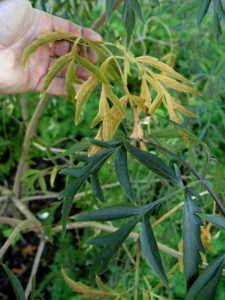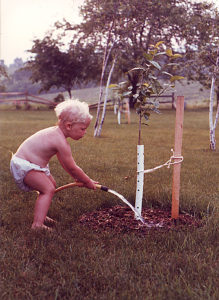Why It’s SO Important to Get Watering Right
July 7th, 2020
I hope you’re staying on top of the garden-watering.
Yeah, water is expensive, and watering the plants eats up a lot of time. But the alternative in a dry, blistering July spell like this can be even more costly in terms of dead plants.
When temperatures rise into the 90s day after day, plant water needs go up with it. The heat itself adds to plant stress.
Your job as plant caretaker is to make sure plants get enough water that they don’t dry and die in this outdoor furnace.
Don’t get faked out by the quick-hit storms we often get in summer. Those can be fakeouts on three fronts:
1.) They’re spotty. It’s entirely possible for one area to get a two-inch dumping but then nothing falls two blocks away.
2.) Summer storms often look like they’re delivering more rain than they really do. I can’t tell you how many times I’ve seen heavy winds and seemingly heavy rains roll through, only to find a quarter-inch or less of water in my rain gauge.
3.) Rain can come down so fast that more of it ends up in the sewer system than around the hydrangea roots.
What really counts is how much moisture is in your soil where your roots are.
Those 10-minute downpours often deposit only enough water to wet the mulch or to penetrate the lawn surface – just enough to keep the grass from going brown and crunchy. That’s why it’s not a good idea to let the color of the grass act as your “rain gauge.”
You can’t always go by wilting plants as your guide either.
For one thing, by the time plants wilt, most of them are already suffering growth setbacks.
For another, plants sometimes wilt for reasons other than lack of water. Flat-out excess heat is enough to make big-leaf hydrangeas wilt during the day, for example. You can tell the difference first thing in the morning. If the leaves have recovered, the plant probably has enough soil moisture. If they’re still wilted, the plant likely needs water.
A third problem is with needled evergreens. They can look perfectly fine for weeks after their roots have completely died from lack of water. Then they suddenly brown all over.
That happens because conifers are good at holding moisture and color in their foliage long after the water flow from the roots has stopped. Think about how your Christmas tree stays green for weeks after it’s been completely severed from the roots.
It’s way too late to do anything once an evergreen has browned. The time to water was weeks ago when the soil went dry.
Fourth – and most ironic – is that plants can wilt from too much soil moisture.
I’ve heard from several people so far this summer who overdid it with the watering and caused root death.
One fellow told me he was losing a pair of new Hinoki cypresses because his landscaper told him to “dig a moat around the plants and fill it three times a day.” That amount of water led to soggy soil, which deprived the roots of oxygen and basically started “suffocating” the plants.
When roots die from rotting or oxygen deprivation, they can no longer deliver moisture from the soil to the leaves and stems. The result is the same as roots that can’t deliver water because it’s not there in the first place – wilting.
The last thing you want to do is give more water to a plant that’s in trouble because of wet soil.

This heat- and water-stressed Black Lace elderberry is letting me know via color loss that it wants water.
Under-watering is far more likely this time of year, though. But either way, I can’t emphasize enough how important it is to get watering right, especially with new plants.
The ideal is to have enough moisture in the soil so that the roots stay consistently damp.
So many plants bite the dust because people under-estimate how often or how much water it takes to do that. Or they just forget or shun watering altogether.
One way to keep track of moisture in the root zone is to get a soil moisture gauge. Stick it in the ground next to plants, and you’ll see exactly how much moisture is in your yard.
That’s more useful information than rain reports. Especially with summer storms, it doesn’t matter if the official measurement from Harrisburg International Airport says a storm dropped an inch if all you got was a two-minute sprinkle.
Also helpful (and cheaper) is sticking your finger in the ground. Go down a few inches and see if the soil is damp, soggy, or bone-dry.
Established plants with well developed roots can deal with both heat and lack of rain a lot better than anything you’ve planted this year… or than annual flowers and vegetables with relatively tiny root systems.
Both of those are most at risk now. Only slightly less at risk are trees and shrubs that have only been in the ground a year or so.
Snavely’s Garden Corner in Chambersburg gives its plant-buying customers one of the best new-plant watering guides I’ve seen.
One reason I like it is because it takes into account soil types, weather, and the varying intervals and water quantities between different-sized plants.

A “moat” or “basin” of soil rings this new boxwood and is now ready for an inch or two of mulch and then water.
Snavely’s recommends the same “moat” around plants that the aforementioned landscaper recommended, although the folks there call it more of a “basin of soil.” The idea is to direct water to the rootball instead of letting it run off.
Delivering the right quantity is where things start to get tricky. It’s not as easy as just saying, “Use the hose for five minutes,” or “Let the sprinkler run for 15 minutes,” or the rule that perplexes people the most, “one inch of water per week.”
That’s because one size doesn’t fit all. So many variables affect water quantity, including your house’s water pressure, the size of hose you’re using, and/or the flow rate of your particular sprinkler, not to mention how well your soil drains, what plants you’re watering, how much mulch you have over the soil, and how dry the soil is to start with.
If you’re using a hose, you can tell how many gallons of water are coming out by getting a bucket of known size and seeing how long it takes to fill it. If you have a two-gallon bucket, for example, and it takes 30 seconds to fill it, then you know you’re delivering about one gallon of water for every 15 seconds you’re running the hose.
Watering wands or soaker hoses laid out underneath mulch are good ways to deliver water, too, Snavely’s says, but whatever you use, water the soil, not over the plant’s foliage. That’ll maximize water delivery to the roots as well as reduce plant disease, which thrives on wet leaves.
So far as how much water to give and how often, Snavely’s offers the following specific guidelines.
For new trees and shrubs:
Pot or rootball size of six to eight inches wide: Deliver two to three gallons of water every three to four days.
Pot/rootball size of eight to 10 inches: Three to four gallons of water every three to four days.
Pot/rootball size of 10 to 16 inches: Four to six gallons of water every four to five days.
Pot/rootball size of 16 to 24 inches: Eight to 10 gallons of water every five to seven days.
Pot/rootball size bigger than 24 inches: 12 to 16 gallons of water every five to seven days.
Note: If you have shale or fast-draining soil instead of clay, water a day sooner in each case.
For new annual and perennial flowers and groundcovers:
Water every two to three days, applying enough so that the soil is thoroughly wet to a depth of three to four inches.
If the soil is shale or fast-draining, bump the timing up to once every day or two.
Regardless of soil type, after two weeks, add a day to the interval as the roots expand. After four weeks, add another day.
For all new plants:
Snavely’s advises using the shorter recommended intervals when temperatures are steadily over 85 degrees. The longer intervals are fine when it’s cooler and cloudier.
Rain has to total at least a half-inch over a 24-hour period to get you off the watering hook, the tip sheet adds.
If you’re not sure how you’re doing, wait 15 to 30 minutes after you’re done watering an area, then remeasure with your finger or soil moisture gauge.
“If it’s moist one-and-a-half to two inches below the soil surface, it should be adequately moist below that – if you’ve been watering consistently,” Snavely’s says.
One other bit of advice Snavely’s suggests is moving your hose around enough that all water soaks in rather than runs off. Especially with knitted-together mulch surfaces, you’ll usually have to wet the surface first and let it soak in for a few seconds to break the surface tension that otherwise causes water to run off.
Finally, be patient. It’s probably going to take more time and more water than you think to do the deed adequately.
If you’re not patient, get a sprinkler or rig up a drip-irrigation system. (Colorado State Extension has an excellent rundown on installing a drip system.)
And remember, if your plants are wilting, the best time to water was yesterday.








